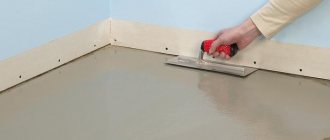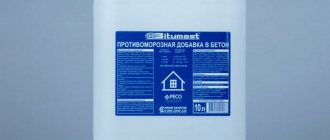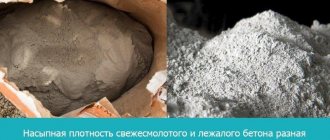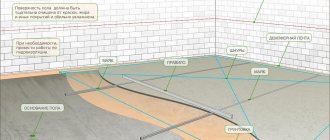A variety of materials are used in the construction and renovation of various types of buildings. Among them, plaster and mixtures for screed construction are considered in demand. Let's look at how long it takes for a particular solution to dry, what it depends on, and what can be done to speed up this process. After reading the article, it will be easier to choose the right compositions to meet specific deadlines for installation work.
Screed thickness Source altpol.ru
Briefly about cement and gypsum binders in building mixtures
Working time and drying speed of the solution depend on the nature of the base component. Most often in construction and repair, mixtures based on gypsum and cement are used. These are mineral compounds that form a highly durable, breathable coating.
Gypsum is characterized by strong water absorption, so the material is used for interior work. The binder component hardens quickly and is environmentally friendly. The relevance of the solution is limited to dry heated rooms in which minimal mechanical load is planned to be applied to the base. It is also worth noting the weak inertness to corrosion, fungus, and mold.
Cement, on the contrary, is not afraid of moisture, rust and biological activity. Resistance to many chemical reagents, sub-zero temperatures, and high pressure is noted. Unlike gypsum, the binder component is a composite of clay, lime and other minerals. This explains the high strength and low water absorption of cement-based mortars. It also takes noticeably longer for the mixtures to dry.
Cement component for mortars Source azom.com
Types, characteristics and purpose of DSP
DSPs are divided into types:
- By functional purpose. Thus, the mixtures are divided according to the specific application: screeds, masonry, plastering, etc.
- Based on the specific gravity of the hardened composition. This indicator indicates the density of the finished solution after hardening.
- According to the strength level of the frozen solution. This indicator characterizes compressive strength and is denoted by the letter “M” and the load number in kg per square centimeter
- By adding binders. Various ingredients can be added to CPS that affect the properties
- Based on binder content. For example, if the ratio of sand to cement is 5:1, the solution is considered lean, and if the proportion is 3:1 or less, then the solution is “fat.” Typically a ratio of 4:1 is used.
Working environment requirements
The timing of finishing work as a whole depends on how long it takes for the floor screed or plaster to dry. However, the quality of the final result also depends on the correctness of the actions performed. There are strict restrictions regarding the conditions under which the leveling process must take place. This applies to the following:
- Temperature . The optimal range is +20-+25 degrees Celsius. Often there are limits from +5 to +35 degrees. Negative indicators significantly reduce the drying rate; in hot conditions, moisture evaporates from the surface too quickly. In both cases, the final product will be of worse quality than declared.
- Relative humidity . Normal levels are considered to be 60-75%. In case of deviations, it is recommended to periodically carry out additional short-term ventilation or moistening of the working surface.
- Ventilation . Drying of the plaster and screed is accompanied by water loss. To prevent air humidity from increasing, it is important to have proper ventilation. However, it is not permissible to create a draft.
The result after violating the requirements for the work technology Source gwd.ru
In addition, the surface of the solution should not be exposed to sunlight. Heat guns cannot be used; heating radiators must be turned off. This will ensure uniform drying of the levelers in terms of plane and thickness.
General information
Depending on the temperature at which the cement hardens, the hardening period also differs. The best temperature is 20°C. Under ideal conditions, the process takes 28 days. In hot regions or during cold periods of the year, it is difficult or impossible to maintain this temperature.
In winter, concreting is required for a number of reasons:
- laying the foundation for a building located on crumbling soils. During the warm period of the year it is impossible to carry out construction;
- In winter, manufacturers make discounts on cement. Sometimes you can really save a lot on material, but storing it until it gets warmer is an undesirable solution, because the quality of the cement will decrease. Pouring concrete on the interior surfaces of buildings and even exterior work in winter is quite appropriate if discounts are available;
- private concreting work;
- In winter there is more free time and it is easier to take a vacation.
The disadvantage of working in cold weather is the difficulty of digging a trench and the need to equip a heating area for workers. Taking into account additional costs, savings do not always occur.
Drying time for leveling mixtures for walls and ceilings
The choice of leveling mixtures is made taking into account the nature of the binding components and how long it takes for gypsum, cement or multi-component plaster to dry on walls and ceilings. This approach allows you to create a high-quality, even base and correctly calculate the timing for subsequent decorative finishing. If the conditions are neglected, cracking and peeling of the coating with low strength indicators is possible.
Let's consider how long it takes for Rotband to dry on a wall with a gypsum base and a cement-based mortar. The first belongs to the group of quick-drying mixtures. On average, the calculation is based on 1 cm per day. When creating the conditions recommended by the manufacturer, a maximum layer of 5 cm can be ready for subsequent finishing in 4 days. However, some analogues under the same circumstances may require 7-14 days, which is important to pay attention to before purchasing.
Plastering with Rotband Source wp.com
See also: Catalog of companies that specialize in finishing materials and related work
The cement composite technology gains strength within 28 days. Manufacturers make mixtures with the addition of various additives that assist the process. Experts recommend starting from an average of 1-2 mm/day.
In addition to temperature, relative humidity, proper ventilation, the nature of the working base influences how long it takes for the plaster to dry. So, if a concrete slab or a wooden frame is being leveled, the time difference will be about 10% in favor of the latter. This is due to the density and water absorption of the materials. In this case, for example, it is unacceptable to plaster a porous foam block without prior priming with impregnating compounds in several layers.
Plastering wooden walls Source basicdecor.ru
How long does cement M 500 dry?
Material labeling is important when choosing a mixture to achieve the required qualities. How long it takes for cement to harden becomes the second most important question. Knowing this is necessary for planning further operations. For example, M 500, under recommended conditions, gains 75% strength within two weeks after the solution begins to harden, and M 400 - 50%.
That is, higher quality cement makes it possible to carry out construction operations much faster. Affects the mixture and temperature proportionally.
The hardening time of cement (any brand) practically stops at 0° C, if the composition does not contain special additives. When water turns into ice, structural destruction of the material occurs. The mixture must not be allowed to freeze until it reaches 90% strength. Brand M 500 gains the required value by the end of the month. The proportions of cement and sand can also affect the rate of hardening. A small amount of binder may slow the curing process if the filler absorbs moisture. Solutions with a large amount of sand require more moisture than more concentrated mixtures.
Drying speed of floor screed
Before choosing a composition for leveling floors, you need to take into account the technical characteristics of the materials, the work methodology and how long it takes for a floor screed made of sand concrete or analogues to dry. Here, mixtures can have different compositions and proportions of basic components.
Sand concrete
The material is a mixture of cement, sand and water with modifying additives. To obtain a high-quality result after pouring, the solution must be further compacted. This is achieved using a handy or vibrating tool. The action is aimed at excluding air from the working mass.
The composition is relatively simple, which leads to frequent preparation of the composite with your own hands. Since the end result is expected to be approximately the same, let’s consider how long it takes M300 sand concrete to dry. This solution meets all the requirements for strength and durability that are relevant for public or residential premises. Also considered pluses are minimal shrinkage and water absorption, resistance to temperature changes and fire.
Sand concrete M300 Source pilomateriali-moskva.ru
The recommended limits for the layer are 3-4 cm. For every 10 mm, it takes about 7 days to dry. That is, a screed with maximum thickness will be ready for subsequent finishing in 21-28 days.
Strengthening schedule
The strength of concrete was measured at certain intervals at different temperatures, and based on this, the following graph was constructed:
With it you can see what the strength will be at any moment from the beginning of pouring, at the selected temperature. The best temperature is 18-22 degrees. Therefore, it is advisable to fill the foundation in the summer. Installation in winter requires additional equipment, heat guns, and waterproofing. This means it will cost and dry much more.
Video description
From the video you can learn about the reasons for a poorly executed screed and how to avoid it:
Under warm floor
Taking into account the minimum thickness for a full screed, the need to hide and protect the heating system, the leveling layer here is on average 6-7 cm. In this case, a liquid water-containing solution of cement, sand and small crushed stone is often used. This coating may take 10 weeks to dry.
Screed for underfloor heating Source buildup.ru
To reduce the time, you can add special hardeners and plasticizers to the working mass to reduce the layer. Experts also recommend considering gypsum-based compositions for the residential sector with light load on floors. And if you resort to the semi-dry method, then subsequent finishing can be carried out within 2-3 weeks.
Hardening time of concrete in formwork
Timely stripping of concrete increases the turnover of formwork equipment and optimizes construction time.
The stripping strength is the strength sufficient to remove the formwork and give the starting load. Typically it is 70% of the design strength (or another value specified in the design documentation).
For non-critical structures, for example, screeds, blind areas and other structures that work only in compression, stripping is permissible on the 3rd–5th day, upon reaching a strength of 30–40% of the calculated one.
Modern concretes with additives can achieve formwork strength in 1–2 days.
The effect of additives on the drying of solutions
According to the rules, the drying process cannot be influenced. But this only applies to environmental conditions. When the timing of the work is more important than the final amount of the estimate, you can consider special compositions and additives to traditional solutions.
For example, if part of the mineral filler is replaced with expanded clay granules, then a small amount of water must be added to the working mass. This will be a mixture suitable for screeding using the semi-dry method. This coating is ready for tiles or installation of a “warm floor” system in 4-7 days. True, it will be permissible to install decor made from moisture-absorbing materials no earlier than after 3 weeks. At the same time, expanded clay, fiberglass, basalt threads, and crumbly expanded polystyrene can be used as an addition.
Reinforcing fiber Source oferteo.pl
Plasticizers help to liquefy the working mass, which has a positive effect on the fluidity of the composition. The addition of such additives also has a positive effect on the drying of solutions. This is justified by a decrease in the rate of water loss from the surface of the screed, which accelerates the same process relative to the lower layers.
Less often in the private sector, the use of mixtures based on fast-hardening cement grades is considered. A screed with the recommended limit can dry in just one day. However, it is important to create strict working conditions and prepare the solution correctly. Information about this can be found on the factory packaging of the selected leveler.
Two main stages of hardening
To achieve the declared qualities, it is necessary to maintain the correct proportions when mixing the solution. Only in this case will the desired strength be achieved. About an hour after pouring the mixture, the process of changing its structure begins. This stage is called setting. How long does it take for the cement mortar to harden before further work is continued?
After a day, the mass becomes so strong that you can walk on it. But it is still far from the declared brand strength. This was only the first stage, called grasping. Next, the hardening process begins. After two days, the mixture gains about 50% strength in the warm season.
It is recommended to begin full operational load and operations for the further construction of the next floor no earlier than 28 days, when the concrete strength approaches 90% as stated. Particular importance is attached to time during the construction of load-bearing structures. If possible, it is better to pour strong foundations a year before the start of main construction. During this time, almost all processes of structure change occur. There will be no significant changes to the geometry of the structure. It is difficult to determine the exact time for complete hardening of a particular cement mortar. It can last for years, but after 12 months these changes do not affect the quality of the building.
Things to remember about concrete foundations
- graph of the strength of concrete as a percentage of a day depending on the ambient temperature
A strip foundation made from concrete blocks or stone should dry for no more than a month, although drying times depend on specific climatic conditions.
- The monolithic foundation dries out for a long time, because there are several horizontal layers. Therefore, the average drying time is one and a half to two months.
- The prefabricated block structure, given the complexity of construction, also takes about a month to dry.
- A pile-screw foundation does not require waiting, because it uses ready-made factory structures on which a grillage or load-bearing walls are already installed;
- Pile-grillage foundations take several weeks to dry, because the grillage is open on each side, so there is an excellent level of ventilation.
Water separation of cement paste
Water separation refers to the extraction of water in cement paste due to the gravitational effect of cement particles and grains of coarse and fine aggregates. Water can appear on the surface of the cement product, between layers of layered concrete, and within the concrete element around aggregates and reinforcement. The presence of such films of water inside the structure leads to delamination and a decrease in the strength of the object under construction.
You can reduce water separation and separation of a solution or mixture by:
- delivery of special ready-made cement-sand mortars and concrete to the construction site by special transport;
- compliance with the technology of laying mixtures and solutions;
- reducing the water-cement ratio using plasticizers;
- introduction of a number of additives - tripoli, clay, bentonite.
Cooperation with AlfaCem
The group is a reputable supplier of consumable raw materials and construction materials to the domestic market. Visit the organization's website to order products for all occasions.
Go to the "Contacts" section to contact us to place an order. Competent managers will help you choose the most suitable building material or consumables, and then implement your order as quickly as possible. All clients are offered competitive prices, which also depend on the discounts and bonus offers introduced. All contractual obligations are guaranteed to be fulfilled.
Water cement ratio
For the normal course of cement hydration processes and giving the solution the necessary mobility, it is necessary to maintain the optimal water-cement ratio (water demand). The water requirement of cement is the minimum amount of water that ensures the production of cement paste of normal thickness. Normal density is the consistency at which the Tetmeyer pestle sinks into the product to the depth established by the standards.
Portland cement has the minimum water requirement - 24-28%. This indicator can be reduced while maintaining the required plasticity of the mixture or solution by introducing special additives - plasticizers. The water requirement of pozzolanic cements in the presence of additives of sedimentary origin is 35-40%.











